Nanomedicines Bearing an Alkylating Cytostatic Drug from the Group of 1,3,5-Triazine Derivatives: Development and Characterization
Abstract
1. Introduction
2. Materials and Methods
2.1. Materials
2.2. Instruments
2.3. Methods
2.3.1. Synthesis of mPEG-b-PLA and PLA
2.3.2. Synthesis of mPEG-b-PCL and PCL
2.3.3. Preparation of Nanoparticles by Nanoprecipitation
2.3.4. Drug Loading
2.3.5. Release Study
2.3.6. MTT Assay
2.3.7. Study of Cell Cycles
2.3.8. Statistical Analysis
3. Results and Discussion
3.1. Synthesis of mPEG-b-PLA and mPEG-b-PCL
3.2. Preparation of Polymer Particles by Nanoprecipitation
3.2.1. Optimization of Preparation Techniques
3.2.2. Stability of Nanoparticles
3.3. Development of Dioxadet/mPEG-b-PLA and Dioxadet/mPEG-b-PCL Nanomedicines
3.3.1. Effect of Initial Drug Amount on the Encapsulation Efficacy and Characteristics of Nanomedicines
3.3.2. Effect of Polymer Molecular Weight on Encapsulation Efficacy
3.3.3. Effect of pH on Encapsulation Efficacy
3.3.4. Effect of Polymer Concentration in Organic Phase on Encapsulation Efficacy
3.3.5. Comparison of Different Conditions for Dioxadet Loading
3.3.6. Morphology Study
3.3.7. Storage Stability of Developed Nanomedicines
3.4. In Vitro Release Study
3.5. In Vitro Biological Evaluation of Developed Nanomedicines
3.5.1. Cytotoxicity Study
3.5.2. Study of Cell Cycles
4. Conclusions
Supplementary Materials
Author Contributions
Funding
Institutional Review Board Statement
Informed Consent Statement
Data Availability Statement
Acknowledgments
Conflicts of Interest
References
- Bahar, A.A.; Liu, Z.; Garafalo, M.; Kallenbach, N.; Ren, D. Controlling Persister and Biofilm Cells of Gram-Negative Bacteria with a New 1,3,5-Triazine Derivative. Pharmaceuticals 2015, 8, 696–710. [Google Scholar] [CrossRef]
- Liu, H.; Long, S.; Rakesh, K.P.; Zha, G.F. Structure-activity relationships (SAR) of triazine derivatives: Promising antimicrobial agents. Eur. J. Med. Chem. 2020, 185, 111804. [Google Scholar] [CrossRef] [PubMed]
- Mibu, N.; Yokomizo, K.; Aki, H.; Ota, N.; Fujii, H.; Yuzuriha, A.; Saneyoshi, S.; Tanaka, A.; Koga, A.; Zhou, J.; et al. Synthesis and Antiviral Evaluation of Some C3-Symmetrical Trialkoxy-Substituted 1,3,5-Triazines and Their Molecular Geometry. Chem. Pharm. Bull. 2015, 63, 935–944. [Google Scholar] [CrossRef] [PubMed]
- Singh, S.; Mandal, M.K.; Masih, A.; Saha, A.; Ghosh, S.K.; Bhat, H.R.; Singh, U.P. 1,3,5-Triazine: A versatile pharmacophore with diverse biological activities. Arch. Pharm. 2021, 354, 2000363. [Google Scholar] [CrossRef] [PubMed]
- Zacharie, B.; Abbott, S.D.; Bienvenu, J.-F.; Cameron, A.D.; Cloutier, J.; Duceppe, J.-S.; Ezzitouni, A.; Fortin, D.; Houde, K.; Lauzon, C.; et al. 2,4,6-Trisubstituted Triazines as Protein A Mimetics for the Treatment of Autoimmune Diseases. J. Med. Chem. 2010, 53, 1138–1145. [Google Scholar] [CrossRef] [PubMed]
- Marín-Ocampo, L.; Veloza, L.A.; Abonia, R.; Sepúlveda-Arias, J.C. Anti-inflammatory activity of triazine derivatives: A systematic review. Eur. J. Med. Chem. 2019, 162, 435–447. [Google Scholar] [CrossRef]
- Tayyab Imtiaz, M.; Anwar, F.; Saleem, U.; Ahmad, B.; Hira, S.; Mehmood, Y.; Bashir, M.; Najam, S.; Ismail, T. Triazine Derivative as Putative Candidate for the Reduction of Hormone-Positive Breast Tumor: In Silico, Pharmacological, and Toxicological Approach. Front. Pharmacol. 2021, 12, 1267. [Google Scholar] [CrossRef]
- Weixin, Y.A.N.; Zhao, Y.; He, J. Anti-breast cancer activity of selected 1,3,5-triazines via modulation of EGFR-TK. Mol. Med. Rep. 2018, 18, 4175. [Google Scholar]
- Wróbel, A.; Kolesińska, B.; Frączyk, J.; Kamiński, Z.J.; Tankiewicz-Kwedlo, A.; Hermanowicz, J.; Czarnomysy, R.; Maliszewski, D.; Drozdowska, D. Synthesis and cellular effects of novel 1,3,5-triazine derivatives in DLD and Ht-29 human colon cancer cell lines. Invest. New Drugs 2020, 38, 990. [Google Scholar] [CrossRef]
- Bespalov, V.G.; Kireeva, G.S.; Belyaeva, O.A.; Senchik, K.Y.; Stukov, A.N.; Maydin, M.A.; Semenov, A.L.; Gafton, G.I.; Guseynov, K.D.; Belyaev, A.M. Experimental study of antitumour activity and effects on leukocyte count of intraperitoneal administration and hyperthermic intraperitoneal chemoperfusion (HIPEC) with dioxadet in a rat model of ovarian cancer. J. Chemother. 2016, 28, 203–209. [Google Scholar] [CrossRef]
- El-Faham, A.; Farooq, M.; Almarhoon, Z.; Alhameed, R.A.; Wadaan, M.A.M.; de la Torre, B.G.; Albericio, F. Di- and tri-substituted s-triazine derivatives: Synthesis, characterization, anticancer activity in human breast-cancer cell lines, and developmental toxicity in zebrafish embryos. Bioorg. Chem. 2020, 94, 103397. [Google Scholar] [CrossRef] [PubMed]
- Bernat, Z.; Szymanowska, A.; Kciuk, M.; Kotwica-Mojzych, K.; Mojzych, M. Review of the Synthesis and Anticancer Properties of Pyrazolo [4,3-e][1,2,4]triazine Derivatives. Molecules 2020, 25, 3948. [Google Scholar] [CrossRef] [PubMed]
- Filov, V.A.; Stukov, A.N.; Malyugina, L.L.; Ivin, B. Study of antitumor activity and toxicity of dioxadet. Exp. Oncol. 1996, 18, 84–86. [Google Scholar]
- Hashem, E.H.; Amr, A.E.G.E.; Nossier, E.S.; Anvar, M.M.; Azmy, E.M. New Benzimidazole-, 1,2,4-Triazole-, and 1,3,5-Triazine-Based Derivatives as Potential EGFRWT and EGFRT790M Inhibitors: Microwave-Assisted Synthesis, Anticancer Evaluation, and Molecular Docking Study. ACS Omega 2022, 7, 7155–7171. [Google Scholar] [CrossRef] [PubMed]
- Mikolaichuk, O.V.; Sharoyko, V.V.; Popova, E.A.; Protas, A.V.; Fonin, A.V.; Vasina, L.V.; Anufrikov, Y.A.; Luttsev, M.D.; Nashchekina, I.A.; Malkova, A.M.; et al. Biocompatibility and bioactivity study of a cytostatic drug belonging to the group of alkylating agents of the triazine derivative class. J. Mol. Liq. 2021, 343, 117630. [Google Scholar] [CrossRef]
- Zhikhoreva, A.A.; Belashov, A.V.; Bespalov, V.G.; Semenov, A.L.; Semenova, I.V.; Tochilnikov, G.V.; Zhilinskaya, N.T.; Vasyutinskii, O.S. Morphological changes in the ovarian carcinoma cells of Wistar rats induced by chemotherapy with cisplatin and dioxadet. Biomed. Opt. Express 2018, 9, 5817. [Google Scholar] [CrossRef]
- Bespalov, V.G.; Kireeva, G.S.; Belyaeva, O.A.; Kalinin, O.E.; Senchik, K.Y.; Stukov, A.N.; Gafton, G.I.; Guseynov, K.D.; Belyaev, A.M. Both heat and new chemotherapeutic drug dioxadet in hyperthermic intraperitoneal chemoperfusion improved survival in rat ovarian cancer model. J. Surg. Oncol. 2016, 113, 438–442. [Google Scholar] [CrossRef]
- Bespalov, V.G.; Vyshinskaya, E.A.; Vasil’eva, I.N.; Semenov, A.L.; Maidin, M.A.; Barakova, N.V.; Stukov, A.N. Comparative Study of Antitumor Efficiency of Intraperitoneal and Intravenous Cytostatics in Experimental Rats with Disseminated Ovarian Cancer. Bull. Exp. Biol. Med. 2017, 162, 383–386. [Google Scholar] [CrossRef]
- Bespalov, V.G.; Alvovsky, I.K.; Tochilnikov, G.V.; Stukov, A.N.; Vyshinskaya, E.A.; Semenov, A.L.; Vasilyeva, I.N.; Belyaeva, O.A.; Kireeva, G.S.; Senchik, K.Y.; et al. Comparative efficacy evaluation of catheter intraperitoneal chemotherapy, normothermic and hyperthermic chemoperfusion in a rat model of ascitic ovarian cancer. Int. J. Hyperth. 2018, 34, 545–550. [Google Scholar] [CrossRef]
- Gershanovich, M.L.; Filov, V.A.; Kotova, D.G.; Stukov, A.N.; Sokolov, I.N.; Ivin, B.A. Multicenter clinical trial of the antitumor drug Dioxadet (phase II). Vopr. Oncol. 1998, 44, 216–220. [Google Scholar]
- Ralhan, R.; Kaur, J. Alkylating agents and cancer therapy. Expert Opin. Ther. Pat. 2007, 17, 1061–1075. [Google Scholar] [CrossRef]
- Maliszewski, D.; Wróbel, A.; Kolesińska, B.; Fraczyk, J.; Drozdowska, D. 1,3,5-Triazine Nitrogen Mustards with Different Peptide Group as Innovative Candidates for AChE and BACE1 Inhibitors. Molecules 2021, 26, 3942. [Google Scholar] [CrossRef] [PubMed]
- Berdiaki, A.; Perisynaki, E.; Stratidakis, A.; Kulikov, P.P.; Kuskov, A.N.; Stivaktakis, P.; Henrich-Noack, P.; Luss, A.L.; Shtilman, M.M.; Tzanakakis, G.N.; et al. Assessment of Amphiphilic Poly- N -vinylpyrrolidone Nanoparticles’ Biocompatibility with Endothelial Cells in Vitro and Delivery of an Anti-Inflammatory Drug. Mol. Pharm. 2020, 17, 4212–4225. [Google Scholar] [CrossRef]
- Caraway, C.A.; Gaitsch, H.; Wicks, E.E.; Kalluri, A.; Kunadi, N.; Tyler, B.M. Polymeric Nanoparticles in Brain Cancer Therapy: A Review of Current Approaches. Polymers 2022, 14, 2963. [Google Scholar] [CrossRef]
- Li, Z.; Tan, S.; Li, S.; Shen, Q.; Wang, K. Cancer drug delivery in the nano era: An overview and perspectives. Oncol. Rep. 2017, 38, 611–624. [Google Scholar] [CrossRef] [PubMed]
- Voeikov, R.; Abakumova, T.; Grinenko, N.; Melnikov, P.; Bespalov, V.; Stukov, A.; Chekhonin, V.; Klyachko, N.; Nukolova, N. Dioxadet-loaded nanogels as a potential formulation for glioblastoma treatment. J. Pharm. Investig. 2017, 47, 75–83. [Google Scholar] [CrossRef]
- Wang, Y.; Qu, W.; Choi, H. Stephanie FDA’s Regulatory Science Program for Generic PLA/ PLGA-Based Drug Products. Am. Pharm. Rev. 2016, 20, 188841. [Google Scholar]
- Osorno, L.L.; Brandley, A.N.; Maldonado, D.E.; Yiantsos, A.; Mosley, R.J.; Byrne, M.E. Review of contemporary self-assembled systems for the controlled delivery of therapeutics in medicine. Nanomaterials 2021, 11, 278. [Google Scholar] [CrossRef]
- Korzhikov, V.; Averianov, I.; Litvinchuk, E.; Tennikova, T.B. Polyester-based microparticles of different hydrophobicity: The patterns of lipophilic drug entrapment and release. J. Microencapsul. 2016, 33, 199–208. [Google Scholar] [CrossRef]
- Mathematical models of drug release. In Strategies to Modify the Drug Release from Pharmaceutical Systems; Elsevier: Amsterdam, The Netherlands, 2015; pp. 63–86.
- Zhang, Y.; Huo, M.; Zhou, J.; Zou, A.; Li, W.; Yao, C.; Xie, S. DDSolver: An add-in program for modeling and comparison of drug dissolution profiles. AAPS J. 2010, 12, 263–271. [Google Scholar] [CrossRef]
- Robles-Bykbaev, Y.; Tarrío-Saavedra, J.; Quintana-Pita, S.; Díaz-Prado, S.; Sabán, F.J.G.; Naya, S. Statistical degradation modelling of Poly(D,L-lactide-co-glycolide) copolymers for bioscaffold applications. PLoS ONE 2018, 13, e0204004. [Google Scholar] [CrossRef] [PubMed]
- Meereboer, K.W.; Misra, M.; Mohanty, A.K. Review of recent advances in the biodegradability of polyhydroxyalkanoate (PHA) bioplastics and their composites. Green Chem. 2020, 22, 5519–5558. [Google Scholar] [CrossRef]
- Ghassemi, A.H.; Van Steenbergen, M.J.; Talsma, H.; Van Nostrum, C.F.; Crommelin, D.J.A.; Hennink, W.E. Hydrophilic Polyester Microspheres: Effect of Molecular Weight and Copolymer Composition on Release of BSA. Pharm. Res. 2010, 27, 2008. [Google Scholar] [CrossRef] [PubMed]
- Feng, S.; Nie, L.; Zou, P.; Suo, J. Effects of drug and polymer molecular weight on drug release from PLGA-mPEG microspheres. J. Appl. Polym. Sci. 2015, 132, 41431. [Google Scholar] [CrossRef]
- Averianov, I.V.; Korzhikov-Vlakh, V.A.; Moskalenko, Y.E.; Smirnova, V.E.; Tennikova, T.B. One-pot synthesis of poly(lactic acid) with terminal methacrylate groups for the adjustment of mechanical properties of biomaterials. Mendeleev Commun. 2017, 27, 574–576. [Google Scholar] [CrossRef]
- Aniśko, J.; Barczewski, M. Polylactide: From Synthesis and Modification to Final Properties. Adv. Sci. Technol. Res. J. 2021, 15, 9–29. [Google Scholar] [CrossRef]
- Liu, Y.; Yang, G.; Zou, D.; Hui, Y.; Nigam, K.; Middelberg, A.P.J.; Zhao, C.X. Formulation of Nanoparticles Using Mixing-Induced Nanoprecipitation for Drug Delivery. Ind. Eng. Chem. Res. 2020, 59, 4134–4149. [Google Scholar] [CrossRef]
- Martínez-Muñoz, O.I.; Ospina-Giraldo, L.F.; Mora-Huertas, C.E. Nanoprecipitation: Applications for Entrapping Active Molecules of Interest in Pharmaceutics. In Nano- and Microencapsulation—Techniques and Applications; IntechOpen: London, UK, 2020. [Google Scholar] [CrossRef]
- Lassalle, V.; Ferreira, M.L. PLA nano- and microparticles for drug delivery: An overview of the methods of preparation. Macromol. Biosci. 2007, 7, 767–783. [Google Scholar] [CrossRef]
- Szczęch, M.; Szczepanowicz, K. Polymeric Core-Shell Nanoparticles Prepared by Spontaneous Emulsification Solvent Evaporation and Functionalized by the Layer-by-Layer Method. Nanomaterials 2020, 10, 496. [Google Scholar] [CrossRef]
- Łukasiewicz, S.; Mikołajczyk, A.; Błasiak, E.; Fic, E.; Dziedzicka-wasylewska, M. Polycaprolactone Nanoparticles as Promising Candidates for Nanocarriers in Novel Nanomedicines. Pharmaceutics 2021, 13, 191. [Google Scholar] [CrossRef]
- Suk, J.S.; Xu, Q.; Kim, N.; Hanes, J.; Ensign, L.M. PEGylation as a strategy for improving nanoparticle-based drug and gene delivery. Adv. Drug Deliv. Rev. 2016, 99, 28–51. [Google Scholar] [CrossRef] [PubMed]
- Iudin, D.; Zashikhina, N.; Demyanova, E.; Korzhikov-Vlakh, V.; Shcherbakova, E.; Boroznjak, R.; Tarasenko, I.; Zakharova, N.; Lavrentieva, A.; Skorik, Y.; et al. Polypeptide self-assembled nanoparticles as delivery systems for polymyxins B and E. Pharmaceutics 2020, 12, 868. [Google Scholar] [CrossRef] [PubMed]
- Stepanova, M.; Korzhikova-Vlakh, E. Modification of Cellulose Micro- and Nanomaterials to Improve Properties of Aliphatic Polyesters/Cellulose Composites: A Review. Polymers 2022, 14, 1477. [Google Scholar] [CrossRef] [PubMed]
- Stepanova, M.; Dobrodumov, A.; Averianov, I.; Gofman, I.; Nashchekina, J.; Guryanov, I.; Klyukin, I.; Zhdanov, A.; Korzhikova-Vlakh, E.; Zhizhin, K. Design, Fabrication and Characterization of Biodegradable Composites Containing Closo-Borates as Potential Materials for Boron Neutron Capture Therapy. Polymers 2022, 14, 3864. [Google Scholar] [CrossRef]
- Maikawa, C.L.; Sevit, A.; Lin, B.; Wallstrom, R.J.; Mann, J.L.; Yu, A.C.; Waymouth, R.M.; Appel, E.A. Block copolymer composition drives function of self-assembled nanoparticles for delivery of small-molecule cargo. J. Polym. Sci. Part A Polym. Chem. 2019, 57, 1322–1332. [Google Scholar] [CrossRef]
- Sanson, C.; Diou, O.; Thévenot, J.; Ibarboure, E.; Soum, A.; Brûlet, A.; Miraux, S.; Thiaudière, E.; Tan, S.; Brisson, A.; et al. Doxorubicin Loaded Magnetic Polymersomes: Theranostic Nanocarriers for MR Imaging and Magneto-Chemotherapy. ACS Nano 2011, 5, 1122–1140. [Google Scholar] [CrossRef]
- Timko, M.; Koneracká, M.; Tomašovičová, N.; Kopčanský, P.; Závišová, V. Magnetite polymer nanospheres loaded by Indomethacin for anti-inflammatory therapy. J. Magn. Magn. Mater. 2006, 300, e191–e194. [Google Scholar] [CrossRef]
- Chalermnon, M.; Cherdchom, S.; Sereemaspun, A.; Rojanathanes, R.; Khotavivattana, T. Biguanide-Based Synthesis of 1,3,5-Triazine Derivatives with Anticancer Activity and 1,3,5-Triazine Incorporated Calcium Citrate Nanoparticles. Molecules 2021, 26, 1028. [Google Scholar] [CrossRef]
- Shetab Boushehri, M.; Dietrich, D.; Lamprecht, A. Nanotechnology as a Platform for the Development of Injectable Parenteral Formulations: A Comprehensive Review of the Know-Hows and State of the Art. Pharmaceutics 2020, 12, 510. [Google Scholar] [CrossRef]
- Chenthamara, D.; Subramaniam, S.; Ramakrishnan, S.G.; Krishnaswamy, S.; Essa, M.M.; Lin, F.-H.; Qoronfleh, M.W. Therapeutic efficacy of nanoparticles and routes of administration. Biomater. Res. 2019, 23, 20. [Google Scholar] [CrossRef]
- Ferrari, R.; Sponchioni, M.; Morbidelli, M.; Moscatelli, D. Polymer nanoparticles for the intravenous delivery of anticancer drugs: The checkpoints on the road from the synthesis to clinical translation. Nanoscale 2018, 10, 22701–22719. [Google Scholar] [CrossRef] [PubMed]
- Piazza, R.D.; Brandt, J.V.; Gobo, G.G.; Tedesco, A.C.; Primo, F.L.; Marques, R.F.C.; Junior, M.J. mPEG-co-PCL nanoparticles: The influence of hydrophobic segment on methotrexate drug delivery. Colloids Surfaces A Physicochem. Eng. Asp. 2018, 555, 142–149. [Google Scholar] [CrossRef]
- Mishra, P.; Dey, R.K. Development of docetaxel-loaded PEG–PLA nanoparticles using surfactant-free method for controlled release studies. Int. J. Polym. Mater. Polym. Biomater. 2018, 67, 535–542. [Google Scholar] [CrossRef]
- Liu, D.; Auguste, D.T. Cancer targeted therapeutics: From molecules to drug delivery vehicles. J. Control Release 2015, 219, 632–643. [Google Scholar] [CrossRef] [PubMed]
- Xie, S.; Tao, Y.; Pan, Y.; Qu, W.; Cheng, G.; Huang, L.; Chen, D.; Wang, X.; Liu, Z.; Yuan, Z. Biodegradable nanoparticles for intracellular delivery of antimicrobial agents. J. Control Release 2014, 187, 101–117. [Google Scholar] [CrossRef] [PubMed]
- Kumar, B.; Jalodia, K.; Kumar, P.; Gautam, H.K. Recent advances in nanoparticle-mediated drug delivery. J. Drug Deliv. Sci. Technol. 2017, 41, 260–268. [Google Scholar] [CrossRef]
- Jannuzzi, A.T.; Yilmaz Goler, A.M.; Bayrak, N.; Yıldız, M.; Yıldırım, H.; Karademir Yilmaz, B.; Shilkar, D.; Venkatesan, R.J.; Jayaprakash, V.; TuYuN, A.F. Exploring the Anticancer Effects of Brominated Plastoquinone Analogs with Promising Cytotoxic Activity in MCF-7 Breast Cancer Cells via Cell Cycle Arrest and Oxidative Stress Induction. Pharmaceuticals 2022, 15, 777. [Google Scholar] [CrossRef] [PubMed]
- Guido, B.C.; Ramos, L.M.; Nolasco, D.O.; Nobrega, C.C.; Andrade, B.Y.; Pic-Taylor, A.; Neto, B.A.; Corrêa, J.R. Impact of kinesin Eg5 inhibition by 3,4-dihydropyrimidin-2(1H)-one derivatives on various breast cancer cell features. BMC Cancer 2015, 15, 283. [Google Scholar] [CrossRef]
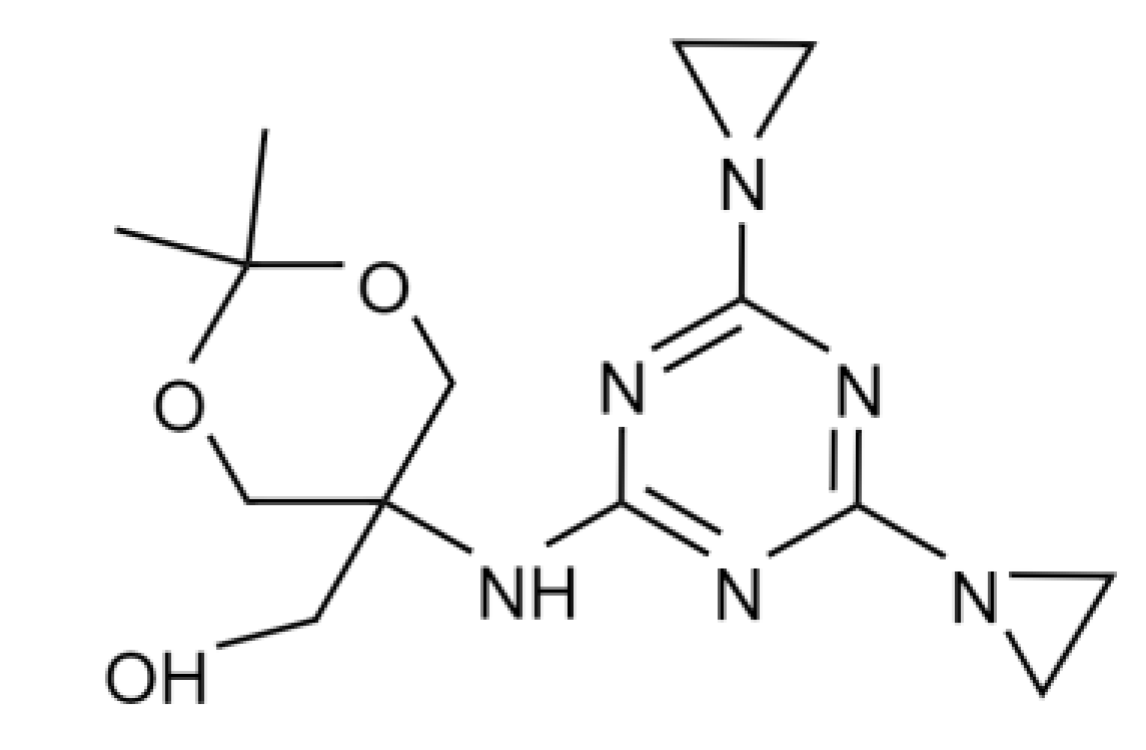
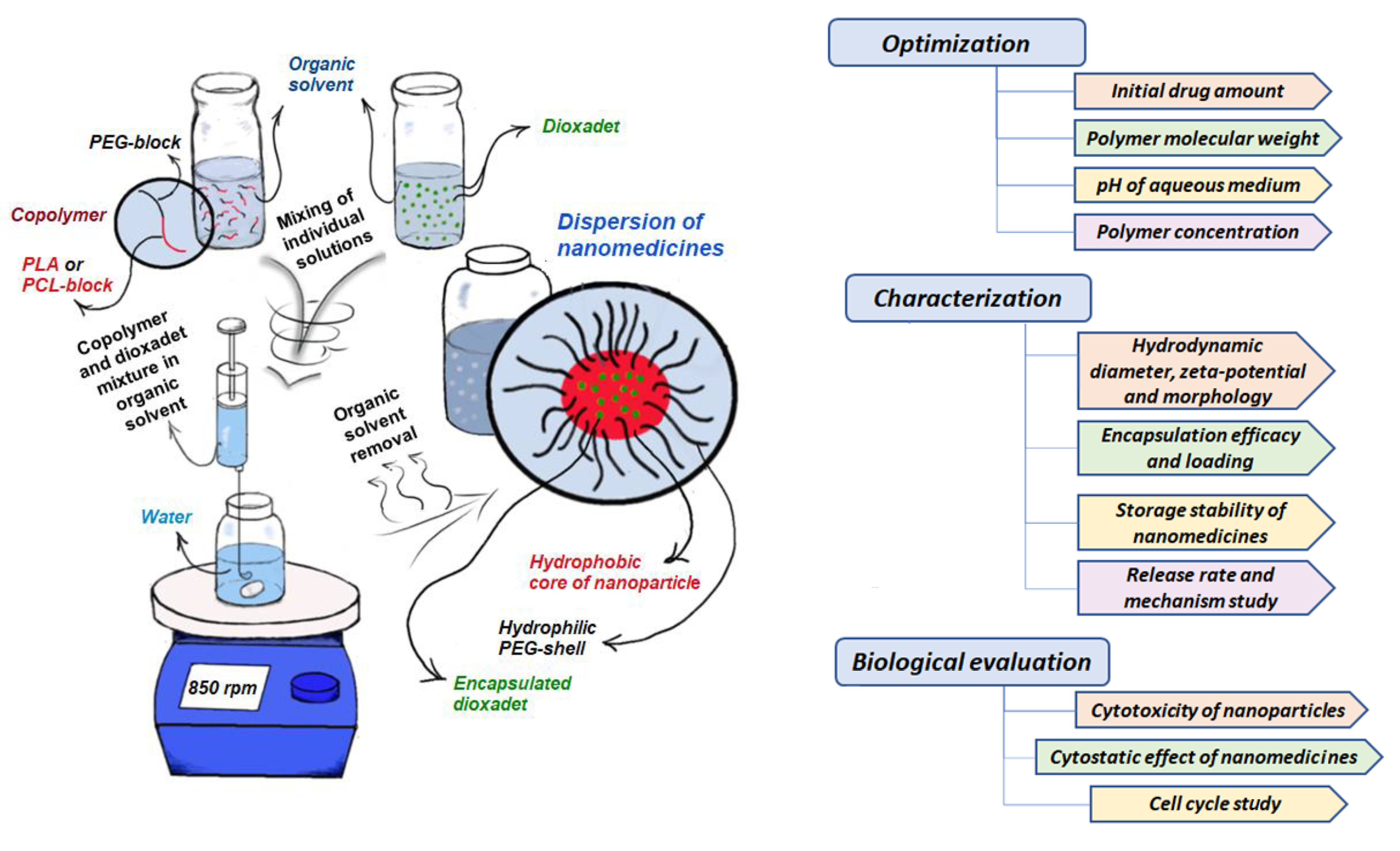
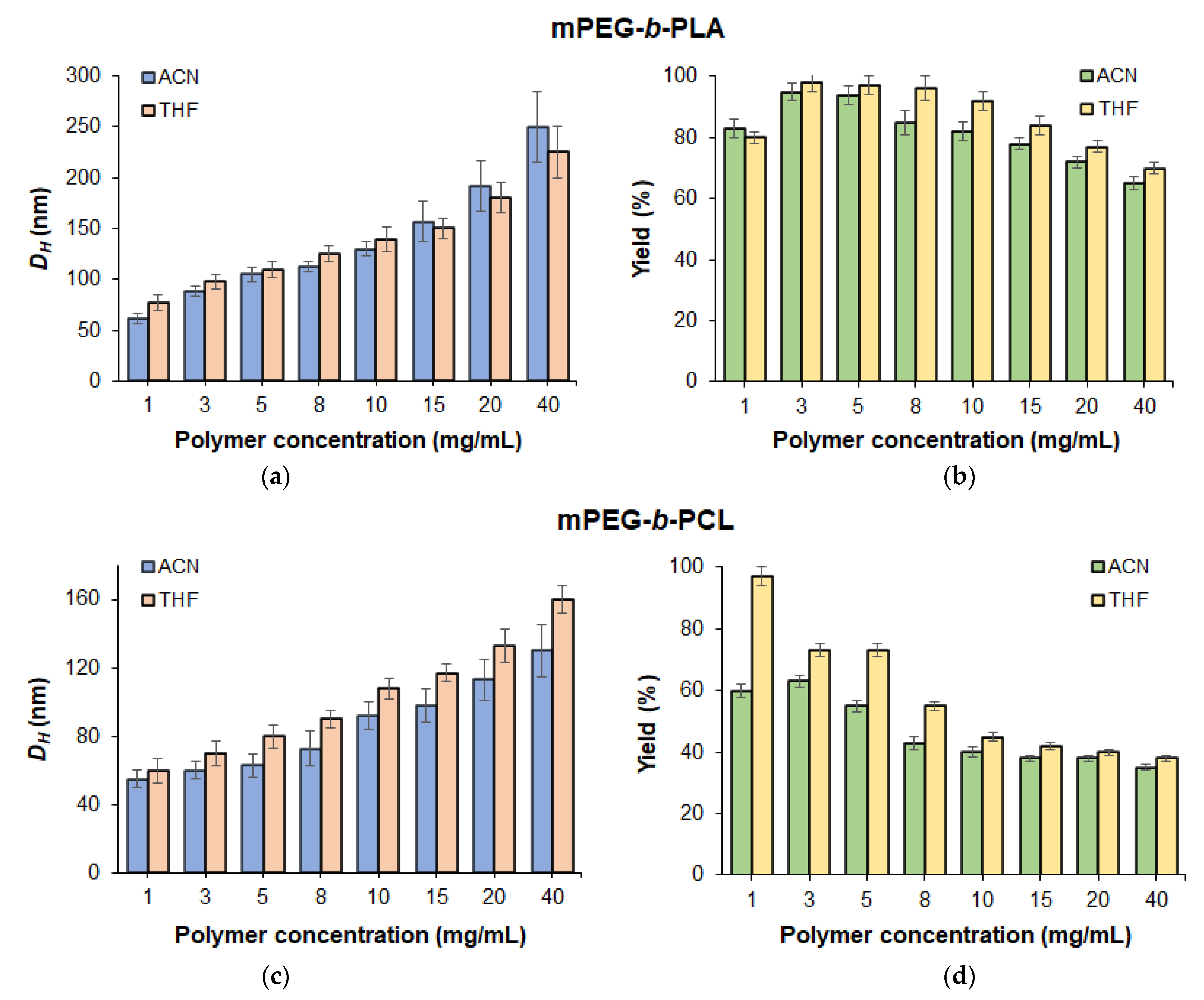
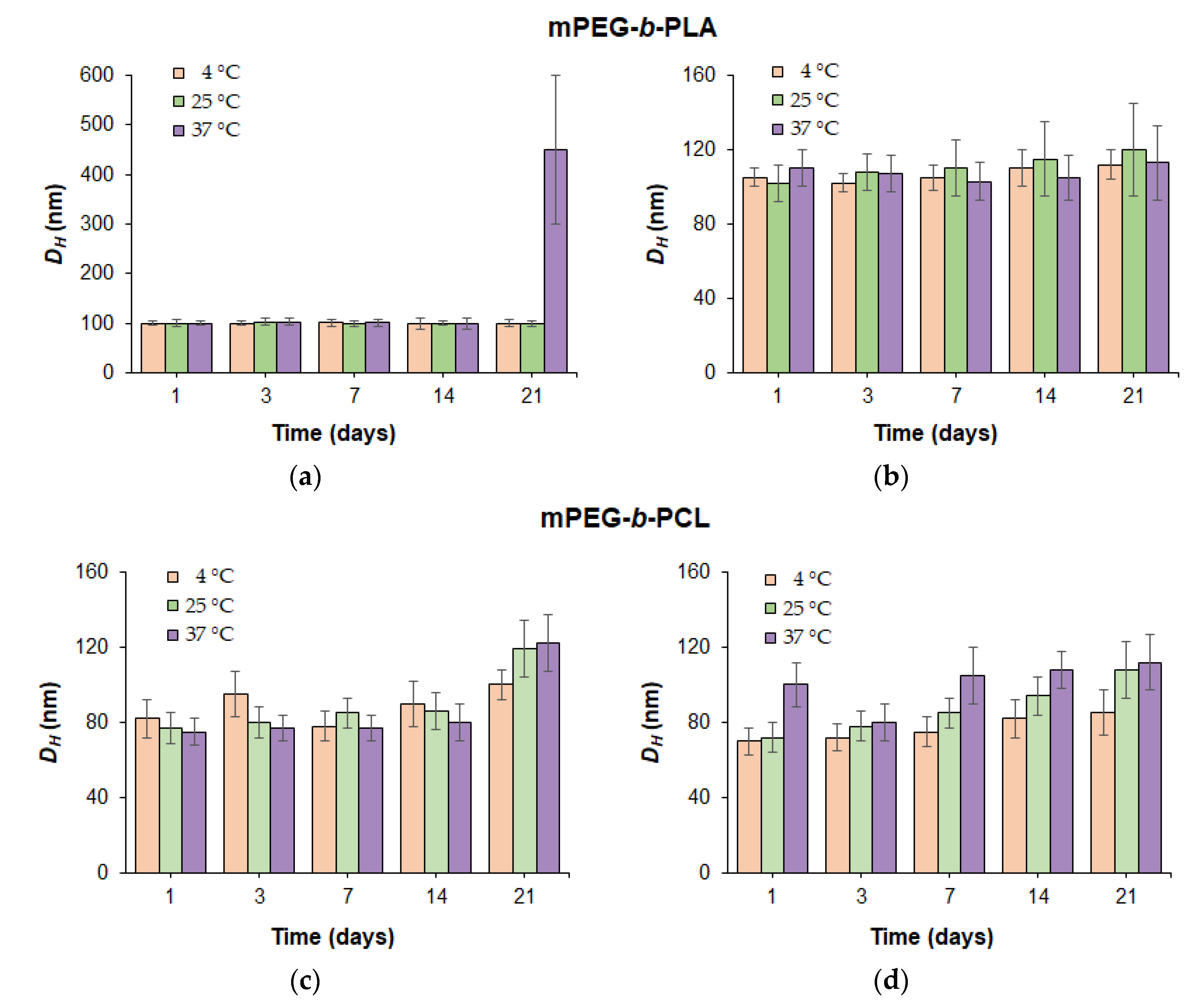
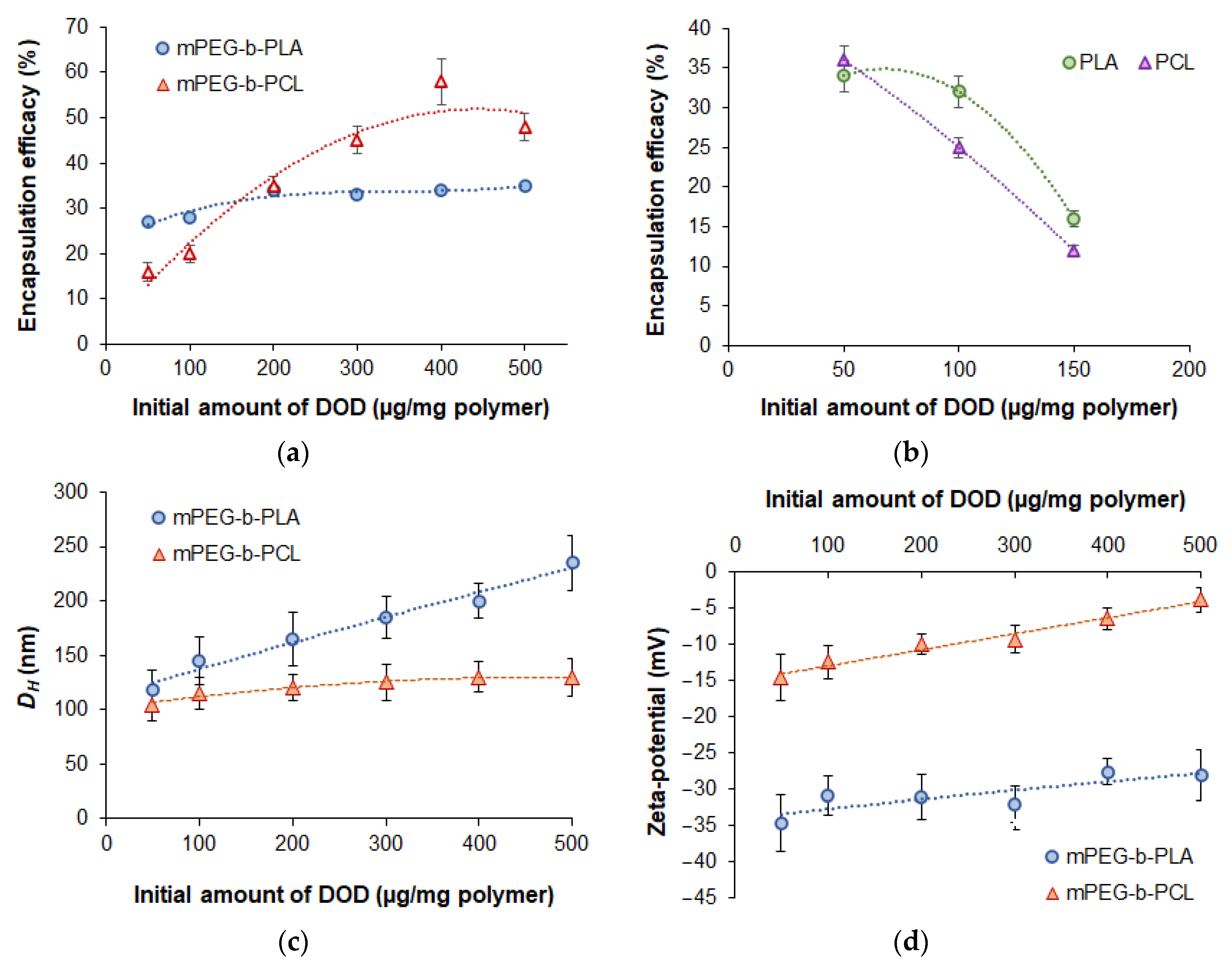
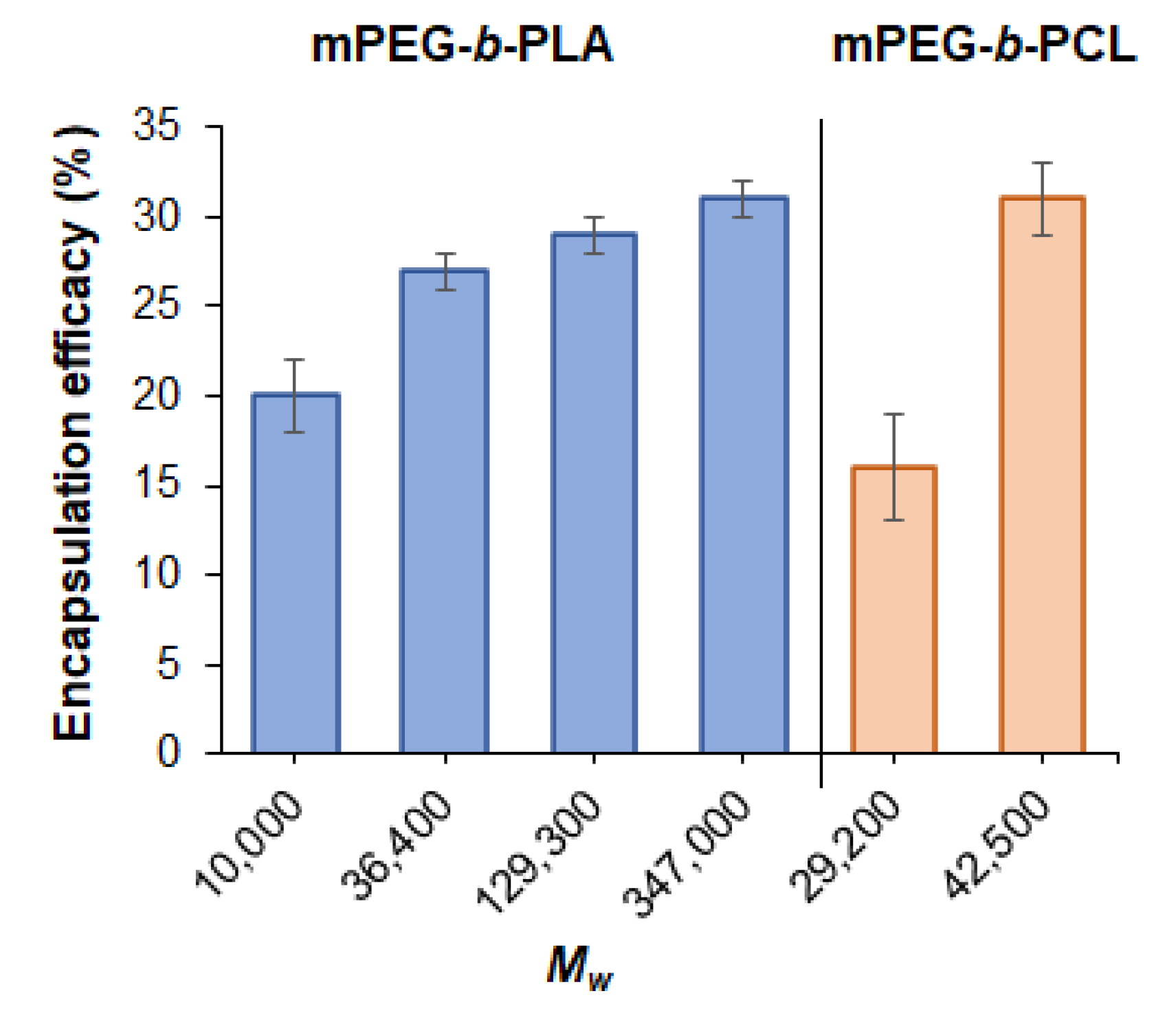
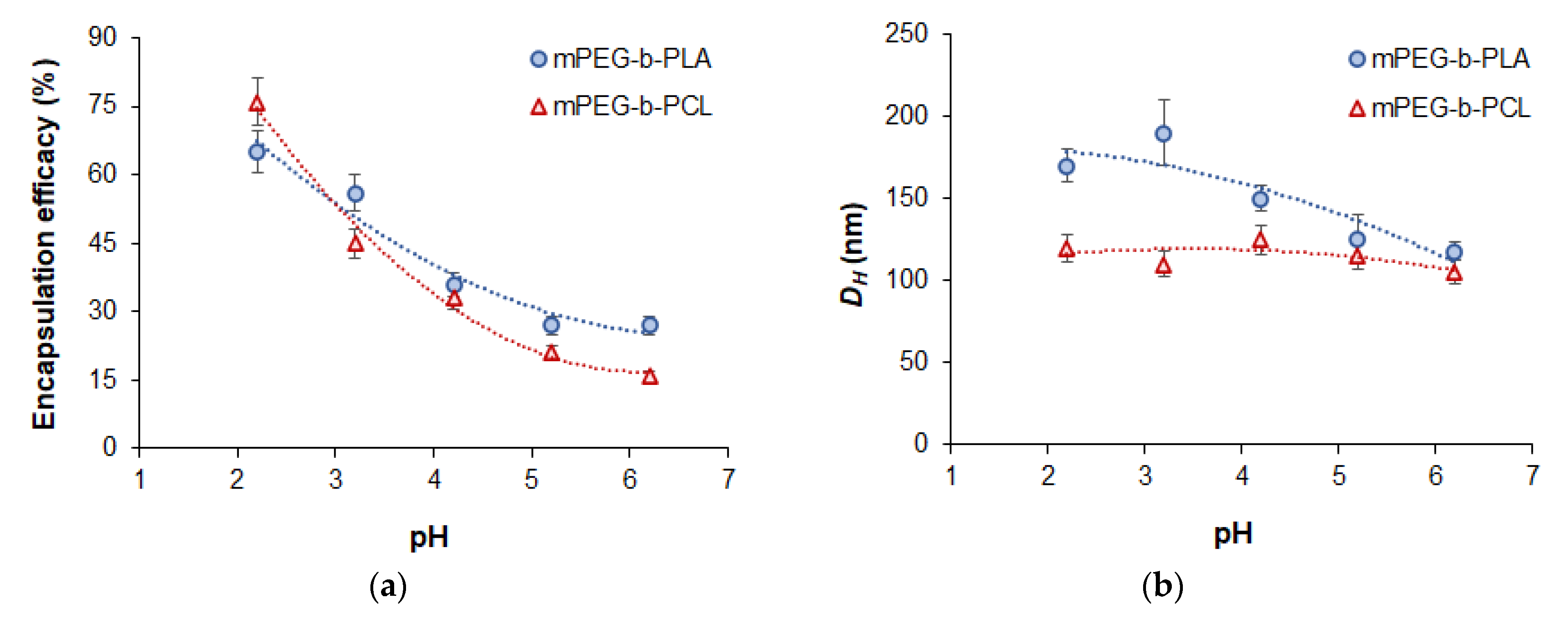
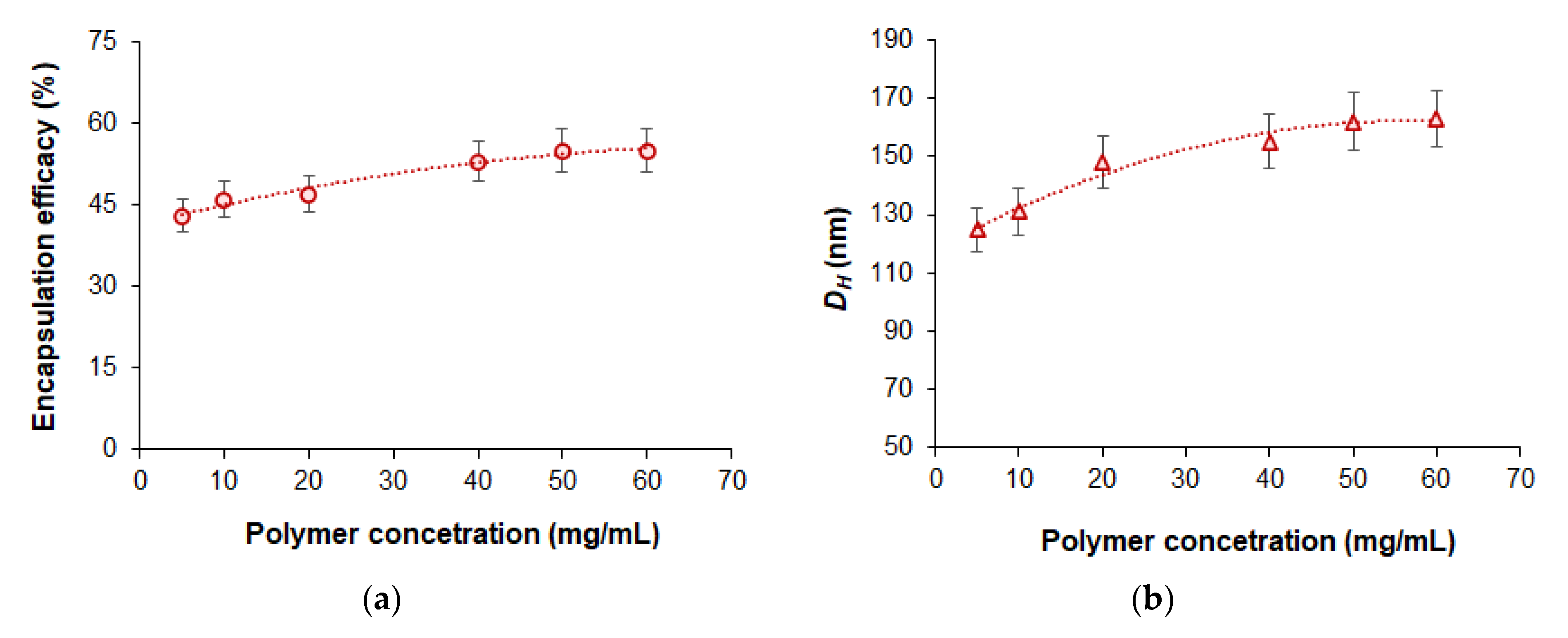
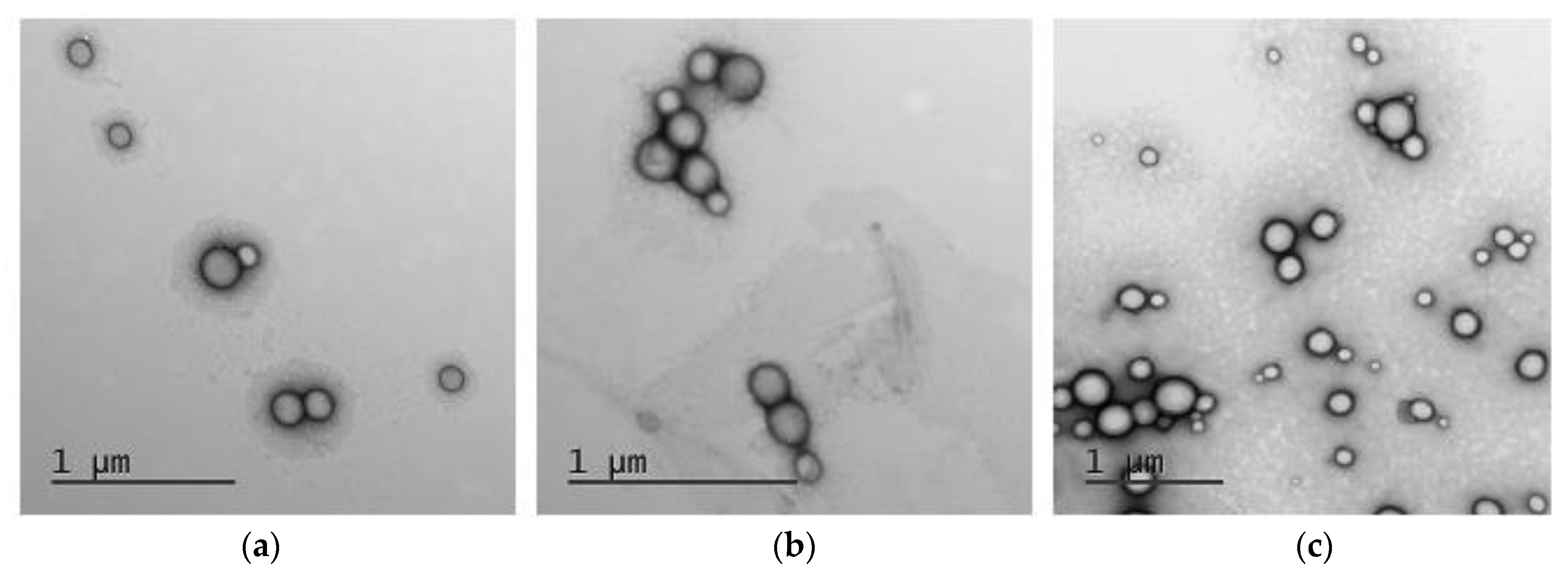

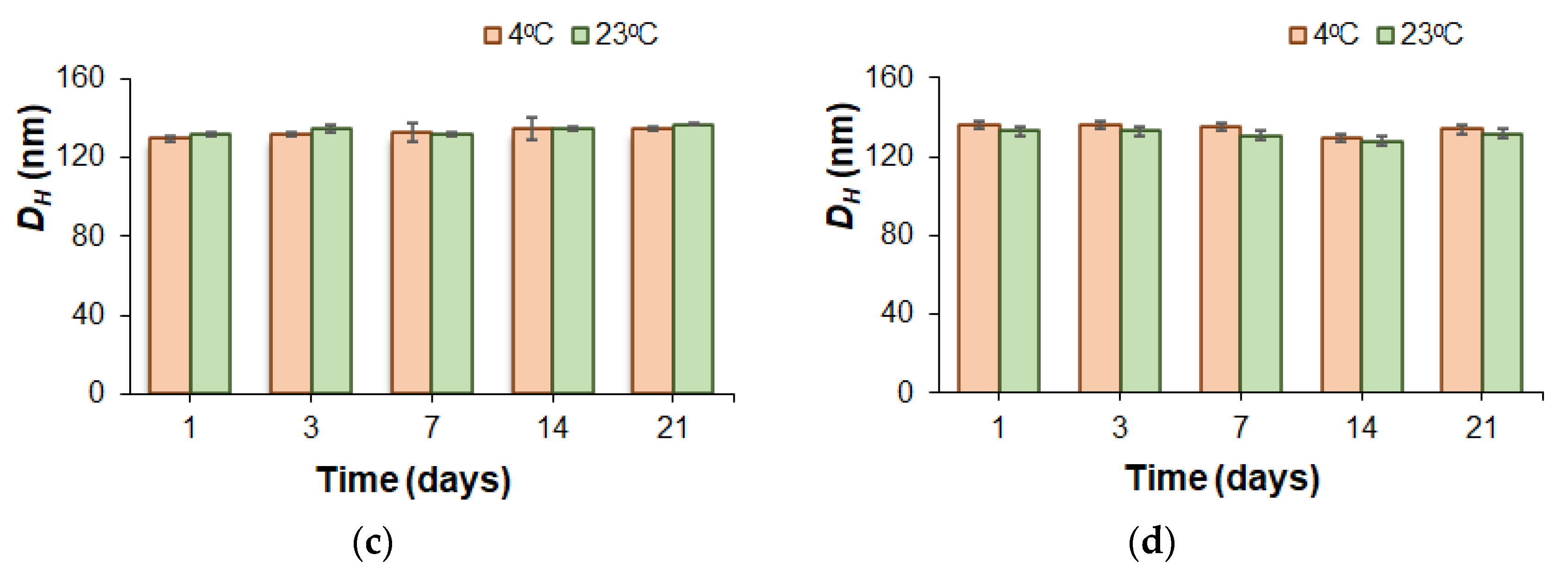
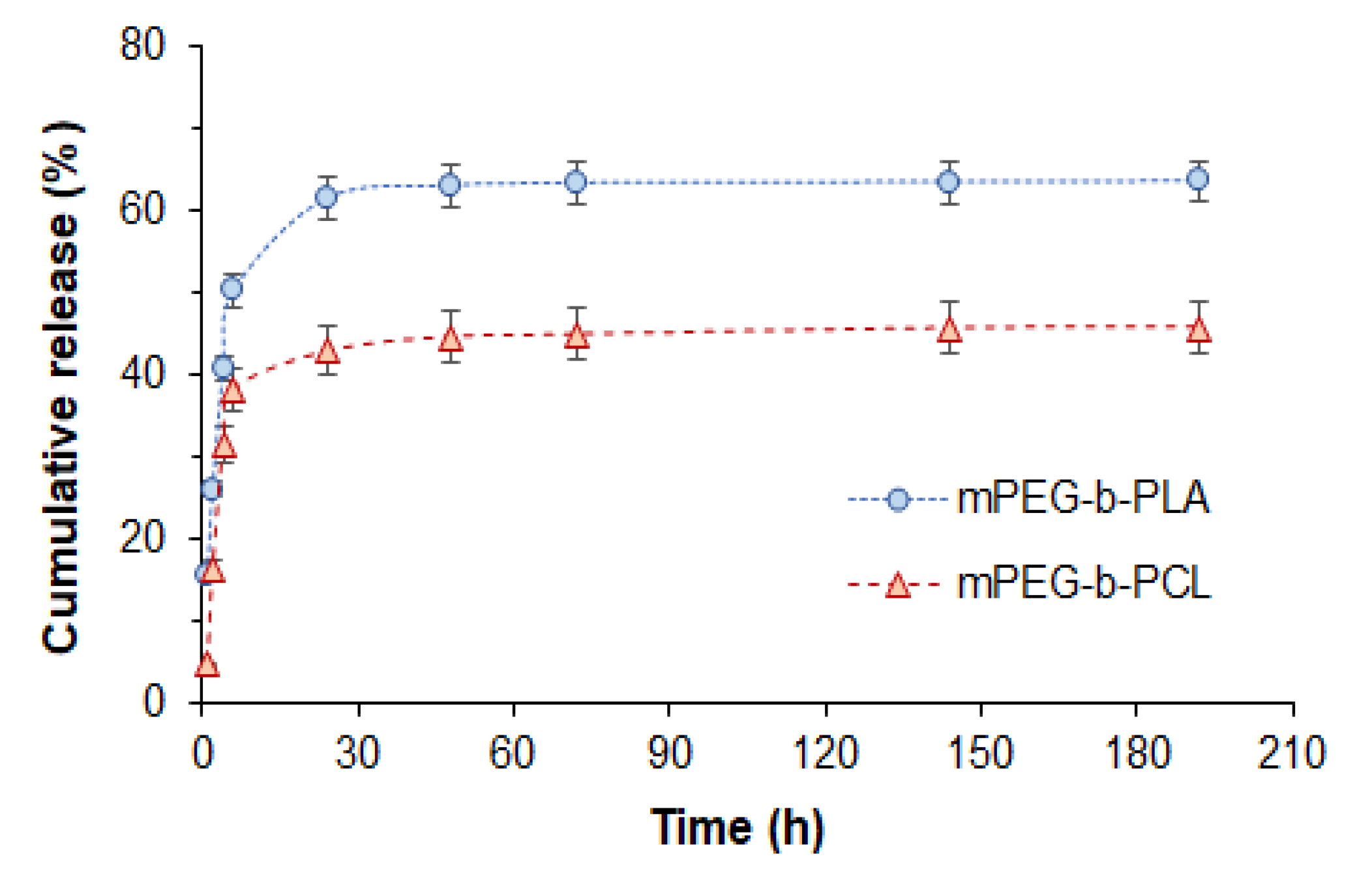
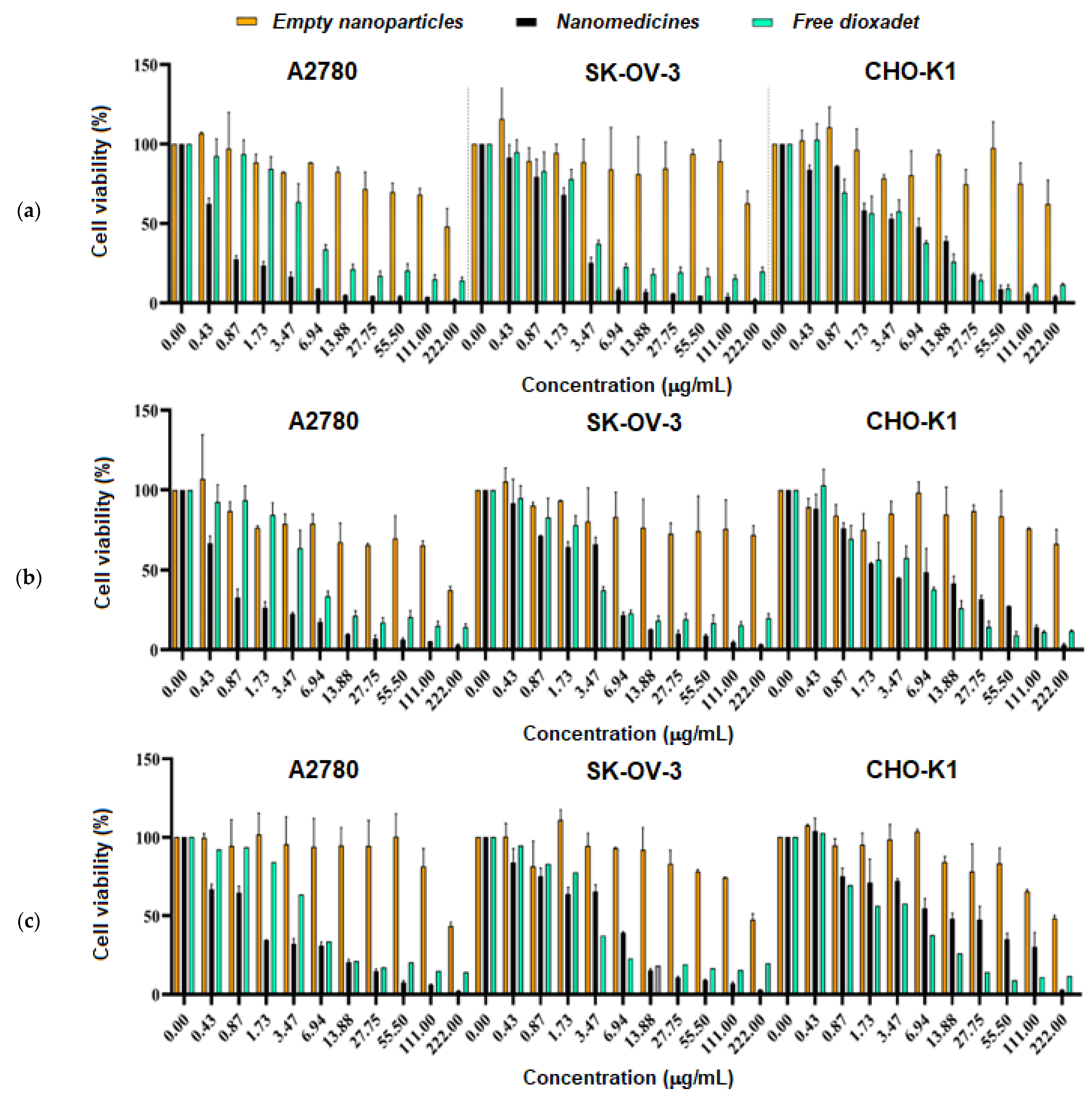
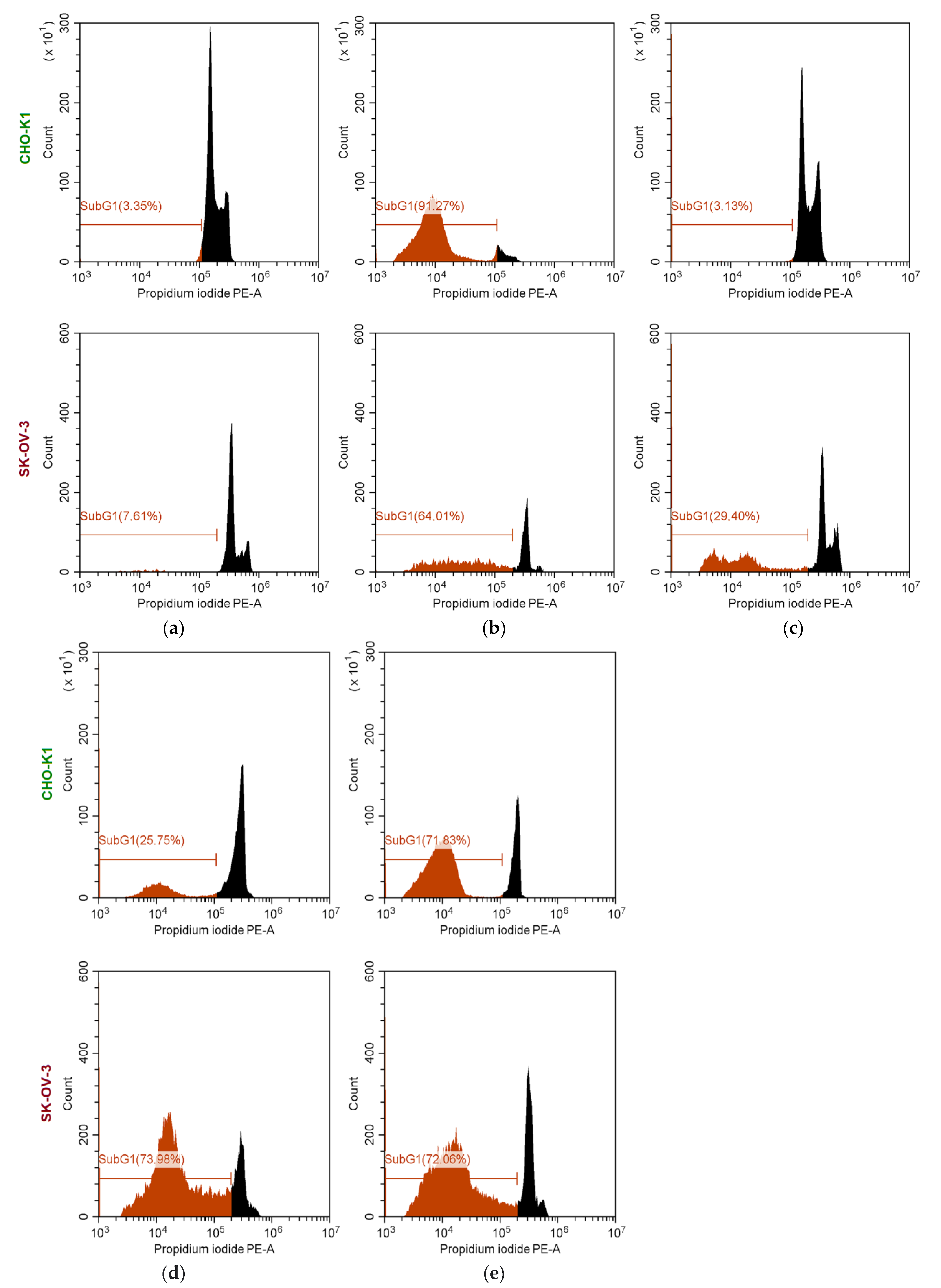
| Sample | Temperature (°C) | Time (h) | Mw | Ɖ | Yield (%) |
|---|---|---|---|---|---|
| PLA | |||||
| #1 | 130 | 1 | 178,000 | 2.31 | 77 |
| #2 | 140 | 1 | 323,000 | 1.33 | 88 |
| #3 a | 140 | 1 | 7000 | 1.14 | 76 |
| #4 a | 140 | 1.5 | 26,200 | 1.13 | 78 |
| PCL | |||||
| #5 | 140 | 24 | 69,000 | 1.50 | 95 |
| #6 b | 140 | 24 | 30,000 | 1.67 | 82 |
| mPEG-b-PLA | |||||
| #7 | 130 | 1 | 36,400 | 1.20 | 71 |
| #8 | 130 | 1.5 | 347,200 | 1.90 | 73 |
| #9 | 140 | 1 | 129,300 | 1.95 | 66 |
| #10 a | 140 | 1.5 | 10,000 | 1.67 | 70 |
| mPEG-b-PCL | |||||
| #11 c | 140 | 4 | 29,200 | 1.51 | 88 |
| #12 d | 140 | 24 | 42,500 | 1.54 | 87 |
| Polymer | Mw | DLS | NTA | ζ-Potential (mV) | Yield (%) | |
|---|---|---|---|---|---|---|
| DH (nm) | PDI | DH (nm) | ||||
| PLA | 26,200 | 135 ± 43 | 0.09 | 143 ± 38 | −37.5 ± 6.8 | 76 |
| mPEG-b-PLA | 36,400 | 115 ± 39 | 0.09 | 120 ± 27 | −32.8 ± 5.0 | 95 |
| PCL | 30,000 | 148 ± 42 | 0.08 | 153 ± 49 | −32.3 ± 6.6 | 65 |
| mPEG-b-PCL | 29,200 | 100 ± 28 | 0.08 | 104 ± 25 | −22.6 ± 5.9 | 72 |
| Encapsulation Conditions | DOD/mPEG-b-PLA | DOD/mPEG-b-PCL | ||||||
|---|---|---|---|---|---|---|---|---|
| Aqueous Phase | Cpolymer in Organic Phase (mg/mL) | Initial DOD/ Polymer (μg/mg) | EE (%) | Yield (%) | Drug Loading (μg/mg Polymer) | EE (%) | Yield (%) | Drug Loading (μg/mg Polymer) |
| Water, pH 6.2 | 5 | 50 | 23 | 74 | 16 | 16 | 44 | 17 |
| Water, pH 3.2 | 5 | 50 | 68 | 70 | 49 | 45 | 33 | 70 |
| Water, pH 6.2 | 5 | 200 | 34 | 72 | 74 | 34 | 46 | 140 |
| Water, pH 3.2 | 5 | 200 | − | − | − | 26 | 33 | 151 |
| Water, pH 6.2 | 5 | 250 500 | 33 30 | 79 70 | 91 167 | 44 48 | 45 43 | 243 592 |
| Water, pH 6.2 | 40 | 250 | 37 | 56 | 152 | 53 | 30 | 545 |
| Model | Time (h) | mPEG-b-PLA | mPEG-b-PCL | ||
|---|---|---|---|---|---|
| R2 | Parameters | R2 | Parameters | ||
| Zero-order F = k0 × t | 200 | 0.5907 | k0 = 0.332 | 0.5624 | k0 = 0.238 |
| 10 | 0.9756 | k0= 9.342 | 0.9837 | k0 = 6.871 | |
| First-order F = 100 × [1 − Exp(−k1 × t)] | 200 | 0.8603 | k1= 0.029 | 0.6303 | k1 = 0.004 |
| 10 | 0.9931 | k1 = 0.129 | 0.9902 | k1 = 0.085 | |
| Higuchi F = kH × t0.5 | 200 | 0.7419 | kH = 5.450 | 0.7061 | kH = 3.898 |
| 10 | 0.9942 | kH = 19.786 | 0.9556 | kH = 14.143 | |
| Korsmeyer–Peppas F = kKP × tn | 24 | 0.9663 | kKP = 23.240 n = 0.325 | 0.9126 | kKP = 15.167 n = 0.358 |
| 10 | 0.9991 | kKP = 16.669 n = 0.624 | 0.9869 | kKP = 8.279 n = 0.881 | |
| Hixson–Crowell F = 100 × [1 − (1 − kHC × t)3] | 200 | 0.7532 | kHC = 4.2 × 10−3 | 0.6228 | kHC = 1.2 × 10−3 |
| 10 | 0.9886 | kHC = 3.9 × 10−2 | 0.9888 | kHC = 2.6 × 10−2 | |
| Hopfenberg F = 100 × [1 − (1 − kHB × t)n] | 200 | 0.8430 | kHB = 6.2 × 10−6 n = 4593 | 0.6466 | kHB = 6.2 × 10−6 n = 693 |
| 10 | 0.9931 | kHB = 8.8 × 10−5 | 0.9902 | kHB = 5.1 × 10−4 | |
| Baker–Lonsdale 3/2 × [1 − (1 − F/100)2/3] − F/100 = kBL × t | 200 | 0.8143 | kBL = 1.1 × 10−3 | 0.7705 | kBL = 3.8 × 10−4 |
| 10 | 0.9892 | kBL = 8.0 × 10−3 | 0.9487 | kBL = 3.8 × 10−3 | |
| Peppas–Sahlin F = k1 × tm + k2 × t(2 × m) | 200 | 0.9738 | k1= 28.476 k2 = 2.997 m = 0.327 | 0.9446 | k1 = 18.784 k2 = 1.809 m = 0.344 |
| 10 | 0.9999 | k1= 60.457 k2 = 76.047 m = 0.148 | 0.9992 | k1 = 576.440 k2 = 580.813 m = 0.030 | |
| Weibull F = 100 × {1 − Exp[−((t − Ti)β)/α]} | 200 | 0.9734 | α = 2.228 β = 0.172 Ti = 0.996 | 0.9933 | α = 2.463 β = 0.083 Ti = 2.000 |
| 10 | 0.9999 | α = 4.946 β = 0.709 Ti = 0.216 | 0.9988 | α = 5.794 β = 0.641 Ti = 0.873 | |
| Gompertz F = 100 × Exp{−α × Exp[−β × log(t)]} | 200 | 0.9625 | α = 1.392 β = 0.575 | 0.9245 | α = 1.741 β = 0.398 |
| 10 | 0.9990 | α = 1.918 β = 1.286 | 0.9979 | α = 2.847 β = 1.433 | |
| Cell Line | IC50 (μg/mL) | |||
|---|---|---|---|---|
| Free DOD | DOD Nanomedicines Based on Copolymer: | |||
| mPEG-b-PCL (Mw = 29,200) | mPEG-b-PLA (Mw = 36,400) | mPEG-b-PLA (Mw = 10,000) | ||
| CHO-K1 | 2.60 | 5.19 | 2.06 | 9.36 |
| A2780 | 4.14 | 0.47 | 0.52 | 1.16 |
| SK-OV-3 | 2.59 | 2.41 | 4.26 | 4.98 |
Publisher’s Note: MDPI stays neutral with regard to jurisdictional claims in published maps and institutional affiliations. |
© 2022 by the authors. Licensee MDPI, Basel, Switzerland. This article is an open access article distributed under the terms and conditions of the Creative Commons Attribution (CC BY) license (https://creativecommons.org/licenses/by/4.0/).
Share and Cite
Sinitsyna, E.; Bagaeva, I.; Gandalipov, E.; Fedotova, E.; Korzhikov-Vlakh, V.; Tennikova, T.; Korzhikova-Vlakh, E. Nanomedicines Bearing an Alkylating Cytostatic Drug from the Group of 1,3,5-Triazine Derivatives: Development and Characterization. Pharmaceutics 2022, 14, 2506. https://doi.org/10.3390/pharmaceutics14112506
Sinitsyna E, Bagaeva I, Gandalipov E, Fedotova E, Korzhikov-Vlakh V, Tennikova T, Korzhikova-Vlakh E. Nanomedicines Bearing an Alkylating Cytostatic Drug from the Group of 1,3,5-Triazine Derivatives: Development and Characterization. Pharmaceutics. 2022; 14(11):2506. https://doi.org/10.3390/pharmaceutics14112506
Chicago/Turabian StyleSinitsyna, Ekaterina, Irina Bagaeva, Erik Gandalipov, Evgenia Fedotova, Viktor Korzhikov-Vlakh, Tatiana Tennikova, and Evgenia Korzhikova-Vlakh. 2022. "Nanomedicines Bearing an Alkylating Cytostatic Drug from the Group of 1,3,5-Triazine Derivatives: Development and Characterization" Pharmaceutics 14, no. 11: 2506. https://doi.org/10.3390/pharmaceutics14112506
APA StyleSinitsyna, E., Bagaeva, I., Gandalipov, E., Fedotova, E., Korzhikov-Vlakh, V., Tennikova, T., & Korzhikova-Vlakh, E. (2022). Nanomedicines Bearing an Alkylating Cytostatic Drug from the Group of 1,3,5-Triazine Derivatives: Development and Characterization. Pharmaceutics, 14(11), 2506. https://doi.org/10.3390/pharmaceutics14112506









